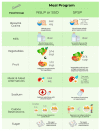Estimates of the Nutritional Impact of Non-Participation in the National School Lunch Program during COVID-19 School Closures
- PMID: 35406001
- PMCID: PMC9003403
- DOI: 10.3390/nu14071387
Estimates of the Nutritional Impact of Non-Participation in the National School Lunch Program during COVID-19 School Closures
Abstract
The COVID-19 pandemic resulted in widespread school closures, reducing access to school meals for millions of students previously participating in the US Department of Agriculture (USDA) National School Lunch Program (NSLP). School-prepared meals are, on average, more nutritious than home-prepared meals. In the absence of recent data measuring changes in children's diets during the pandemic, this article aims to provide conservative, back-of-the-envelope estimates of the nutritional impacts of the pandemic for school-aged children in the United States. We used administrative data from the USDA on the number of NSLP lunches served in 2019 and 2020 and nationally representative data from the USDA School Nutrition and Meal Cost Study on the quality of school-prepared and home-prepared lunches. We estimate changes in lunchtime calories and nutrients consumed by NSLP participants from March to November 2020, compared to the same months in 2019. We estimate that an NSLP participant receiving no school meals would increase their caloric consumption by 640 calories per week and reduce their consumption of nutrients such as calcium and vitamin D. Because 27 to 78 million fewer lunches were served per week in March-November 2020 compared to the previous year, nationally, students may have consumed 3 to 10 billion additional calories per week. As students return to school, it is vital to increase school meal participation and update nutrition policies to address potentially widening nutrition disparities.
Keywords: COVID-19; National School Lunch Program; diet quality; disparities; obesity; school closures; school lunch; school meal.
Conflict of interest statement
The authors declare no conflict of interest. The funders had no role in the design of the study; in the collection, analyses, or interpretation of data; in the writing of the manuscript, or in the decision to publish the results.
Figures


References
-
- United States Department of Agriculture Economic Research Service National School Lunch Program. [(accessed on 19 August 2019)]; Available online: https://www.ers.usda.gov/topics/food-nutrition-assistance/child-nutritio....
-
- Ralston K., Treen K., Coleman-Jensen A., Guthrie J. Children’s Food Security and USDA Child Nutrition Programs. United States Department of Agriculture Economic Research Service; Washington, DC, USA: 2017.
-
- United States Department of Agriculture Food and Nutrition Service Child Nutrition Tables: National Level Annual Summary Tables: FY 1969–2019. [(accessed on 19 February 2020)]; Available online: https://www.fns.usda.gov/pd/child-nutrition-tables.
-
- Moore Q., Hulsey L., Ponza M. Factors Associated with School Meal Participation and the Relationship Between Different Participation Measures. Mathematica Policy Research; Princeton, NJ, USA: 2009. p. 173. Final Report.
MeSH terms
Grants and funding
LinkOut - more resources
Full Text Sources
Medical
Research Materials

